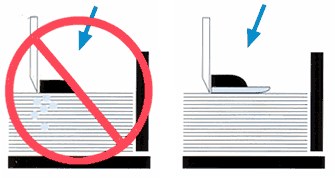FINISHING
| Cutting
of sheets
Too
strong clamp pressure could damage the microcapsules
which can then activate the coating and reduce copying
capacity therefore we recommend the following: |
 |
- adjust the pressure of the pressing shaft
at minimum to avoid sliding of paper stack
- adjust hard gum to the pressing shaft
- cut more stacks at a time to divide pressure
- stack height should be lower to avoid sliding of paper
during cutting
- use sharp blades under the angle from 19 to 21 degrees.
Slitting
of reels
The pressure sensitive character
of CB and CFB carbonless copy paper demands slitting machines
with free rollers. Traction cylinders can be used only at
minimum pressure. The winding should be of even strength
throughout the whole roII. Too tight of too loose winding
can cause damage to the microcapsulated coating and its
activation. Slit reels should be packed properly.
Glueing of sets
| When
making sets of Aerocopy carbonless copy paper use
glue which will provide splitting of sets without
manual cutting.
Forming of sets is based on a fact that sheets coated
with CB and CF coating possess higher absorption
of glue than those which are not coated. The glue
penetrates among the uncoated sides of sheets and
binds them together, it does not bind the uncoated
sheets.
Gluing
procedure:
Carbonless copy paper is coulated according to the
set required. CB sheet is always the first one in
a set and CF the last one. Between them a required
number of CFB sheets is inserted.
Collated paper is cut on the guillotine to the final
size. Splitting of sets can be achieved only on
the smooth glued and cut side. |
|
|
|
Collated
cut paper should be carefully stacked on a solid
base up to the height of 30 cm maximum. On top of
this paper a plate is placed 0,5 cm from the edge
which is to be glued and then applied with a weight
of 1 kg.
Before use stir the glue well.
The edge of the paper stack is coated with fanapart
glue. It is applied with a brush (4 to 5 cm long
fibres) used for this purpose. The glue is applied
horizontally from the centre towards the edges,
evenly on the whole surface. If one coating is not
sufficient two applications are possible. After
use rinse the brush in water.
Drying time is approximately 5 minutes, considering
paper grammage and climate conditions of the working
place. Sets can be split by simply moving a hand
from the bottom of the stack towards the top which
will prevent the gluing of sets into a pad. Final
drying will take another hour or two. |
Additional information:
Sorting of paper into sets:
Glue for sets is intended for glueing of Aerocopy carbonless
copy paper. We cannot guarantee set formation of other producers
copy paper.
Impact of the fibre direction:
Fibre direction of all papers in a set has to be in the
same direction. To avoid corrugated edge, gluing should
be done on the side which has the fibre direction parallel
to the glued edge; in such a way optimal results are achieved.
Paper cutting:
When cutting, it is important that the clamp on the guillotine
is adjusted to the minimum pressure which still permits
normal operating and does not damage the CB coating. Cutting
blades should be clean and sharp with no oil or adhesive
residue if self adhesive paper had been previously cut.
Time from cutting to gluing of paper should be very short
in order to assure correct gluing.
Printing ink impact:
Printing ink reduces the effect of the glue to the set.
The glued edge of the CFB and CF sheet should be printed
at least 3 mm from the edge.
Block formation:
If the sets tend to form a block it is recommended to dilute
the glue in a ratio 1:3 (1 part of water, 3 parts of glue)
and to shorten the drying time before splitting. We recommend
test gluing with a smaller quantity of paper.
Glue for sets:
Glue should not be left open, keep the container closed
after use. Store the glue at the temperature above 5°C.
If frozen it cannot be used any longer. Shelf life is 12
months if stored properly. The glue is not hazardous to
health.
Gluing - general
instructions
Aerocopy paper can be glued
with ordinary glues as well as on surface, in dots or in
lines.
These methods are suitable for the production of pads and
continuous forms. The use of chemically neutral glues is
recommended.



